
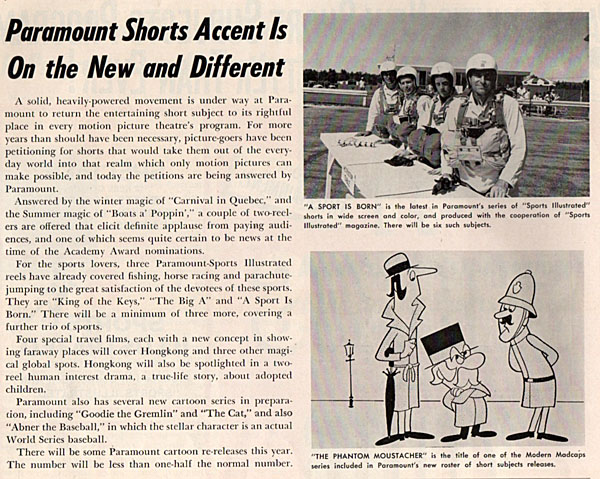
For Paramount executive Seymour Kneitel, this was a pretty good year. The Paramount Cartoon Studio had survived the sale of its library and its established characters to Harvey Comics. Paramount Pictures ordered a second year of 20 new theatricals – and production on Popeye TV films continued, and there was potential for further King Features TV cartoons.
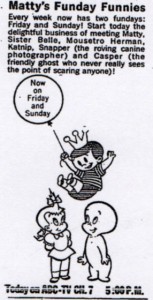
This ad from the LA Times (10/2/60) reflects the now twice-a-week telecasts of Matty’s Funday Funnies.
Let’s look at the recurring characters being offered: Professor Schmaltz, Kozmo the kid from Mars, Goodie Gremlin (a variation of Casper) and “Specs, Chub and Goop”, an ersatz “Our Gang”. For some reason Kneitel looked to one of the remaining Hollywood animation studios – Walter Lantz – for some inspiration, basing one cartoon on a annoying woodpecker, another on a pair of penguins (Chilly Willy, anyone?) trying to sabotage a cargo ship’s watch dog.
One creative highlight, Bouncing Benny. Former Fleischer/Famous crew members Graham Place and Otto Feuer had been tinkering with a new method of limited animation. The result, a cut out/stop-motion technique, was given a try out by Kneitel on Benny. The cartoon was cute, but it wasn’t a game changer – and was not used again (though I believe Place and Feuer produced a few TV commercials with their technique).And then there was “The Cat”. Desperate for a “Star”, Paramount foist this non-entity (originally planned as a one-off entry in the Modern Madcaps) upon the public in four shorts. Evidence that this “series” was rushed to comply with Paramount’s salemen’s demand for some sort of cartoon “front man” is the gap of six months between the first film and the second one – and another six months wait for the third entry. They are not completely without merit – a catchy song in the first one, clever ideas and – in the first two – witty scripts by Irv Spector – but their threadbare execution and limited animation must have looked awful on the big screen.
Reaching for straws, Kneitel even made a two-picture deal with Marge to revive Little Lulu – adapting two John Stanley “Little Lulu” stories (without credit to Stanley) to animation for the first time.
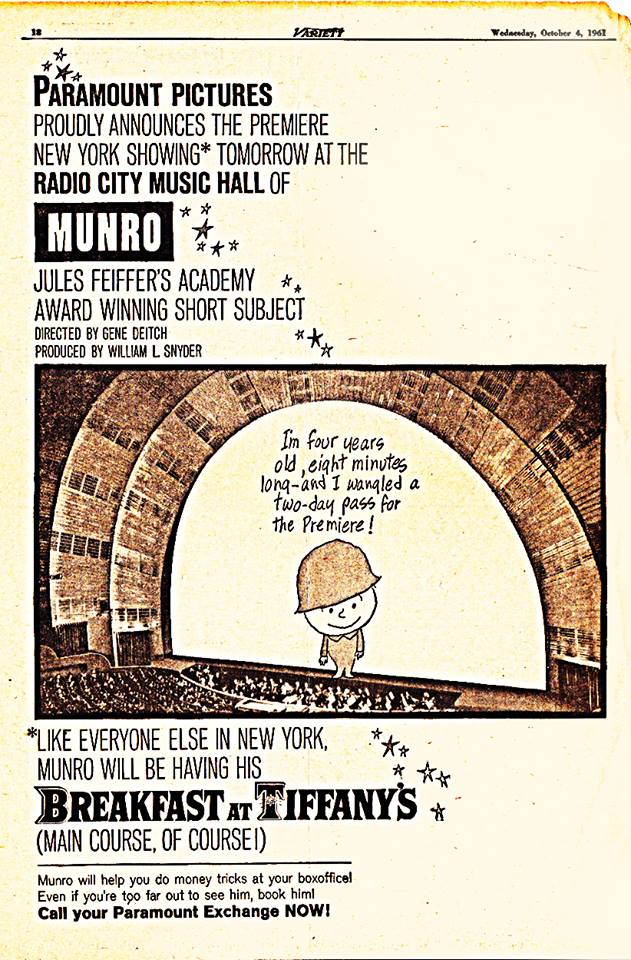
Regardless, Paramount was still high on animated shorts – in fact it even picked up an independent film to augment its schedule: Munro, directed by Gene Deitch (who was also producing King Featuers Popeye TV cartoons from his studio in Prague) and based on a story by Jules Feffier. It was released by Paramount in October 1961 – after it had won an Oscar – and the studio began negotiations with Rembrandt Films for more eclectic Deitch animated theatrical shorts. It is not known what Kneitel thought of this relationship. Perhaps he was too preoccupied getting “The Cat” into theaters and delivering TV Popeye cartoons to King Features.
That said, and without further ado, let’s take a closer look at the 1960-61 in-house Paramount cartoons.
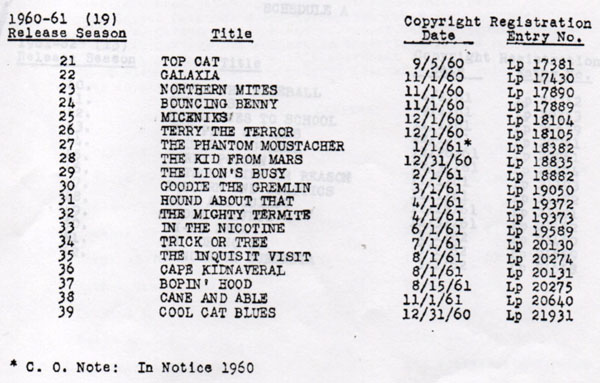
Missing from this release list above is the 20th title for the season – a Noveltoon featuring Little Lulu, “Alvin’s Solo Flight”.
Eight (8) Modern Madcaps

This shot from BOUNCING BENNY looks like a swipe from Disney’s “Baby Weems”.
BOUNCING BENNY (11/60) Kneitel/Graham Place-Otto Feuer. A young married couple raise a (literally) bouncing baby boy.
TERROR THE TERROR (12/60) Kneitel/Johnson. Professor Schmaltz, Child Psychiatrist, tries to tame bratty little Terry.
THE PHANTOM MOUSTACHER (1/61) Kneitel/Waldman. Sir Percival Prunepit is the “Phantom Moustacher” (who draws mustaches on everything). His butler, Smedley, tries to stop him.
THE KID FROM MARS (2/61) Kneitel/Tafuri. Kosmo lands on Earth and plays havoc with his ray gun at a circus.
THE MIGHTY TERMITE (4/61) Kneitel/Tafuri. Professor Schmaltz tries to study a hungry termite.
IN THE NICOTINE (6/61) Kneitel/Spector. Chain-smoking Charlie Butts is sent to Smokers Anonymous by his harried wife. NOTE: first large role for Eddie Lawrence, as the voice of Charlie Butts.
THE INQUISIT VISIT (7/61) Kneitel/Spector. Chas Huntington and his “Person To Person” style TV show visit the home of Gaby Lament (a Zsa Zsa Gabor type).
Eight (8) Noveltoons
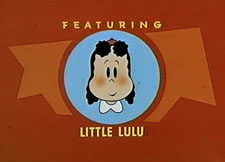
The titles from ALVIN’S SOLO FLIGHT; Little Lulu’s return to the Paramount Cartoon Studio
MICENIKS (12/60) Jazz playing beatnik mice try to elude a cat from the country.
THE LION’S BUSY (2/61) Kneitel/Taras. Spoiled millionaire Sir Reginald Tweedledum IV is sent to Africa to kill an animal and uphold a family tradition.
GOODIE THE GREMLIN (4/61)Kneitel/Taras. Goodie undoes all the mischief and mayhem caused by the other Gremlins.
ALVIN’S SOLO FLIGHT (4/61) Kneitel/Tafuri. Tubby and Lulu take little Alvin to the beach. There he grabs some balloons and floats away.
HOUND ABOUT THAT (4/61) Kneitel/Taras. A fox teases a near-sighted dog.
TRICK OR TREE (7/61) Kneitel/Reden. A stubborn woodpecker is preventing the construction of a new super-highway.
CAPE KIDNAVERAL (8/61) Kneitel/Waldman. Specs and his two friends, Chub and Goop, build a moon rocket.
 Four (4) The Cat
Four (4) The Cat
TOP CAT (7/60) Kneitel/Klein. The head of Blocbuster Pictures, J.C. Bandwagon, sends his men out to find a new star.
COOL CAT BLUES (1/61) Kneitel/Spector. The Cat is hired as a bodyguard for Smilin’ Ed Solvent (a take-off on Ed Sullivan).
BOPIN’ HOOD (8/61) Kneitel/Spector. A hip cat named “Bopin’ Hood” (and his band) comes to Squaresville, where jazz has been outlawed.
CANE AND ABLE (10/61) Kneitel/Spector. A take-off of “Bat Masterson”, The Cat goes west to clean up a gambling operation in a rough town.
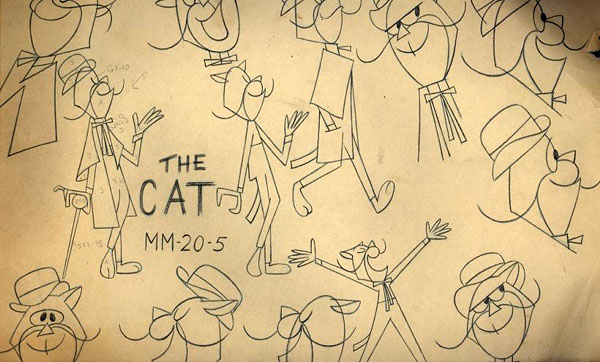
(Thanks, Ken Layton)


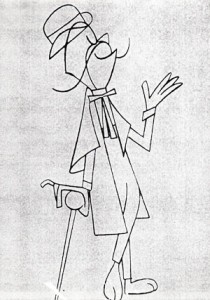
 Jerry Beck is a writer, animation producer, college professor and author of more than 15 books on animation history. He is a former studio exec with Nickelodeon Movies and Disney, and has written for The Hollywood Reporter and Variety. He has curated cartoons for DVD and Blu-ray compilations and has lent his expertise to dozens of bonus documentaries and audio commentaries on such. Beck is currently on the faculty of CalArts in Valencia, UCLA in Westwood and Woodbury University in Burbank – teaching animation history. More about Jerry Beck [
Jerry Beck is a writer, animation producer, college professor and author of more than 15 books on animation history. He is a former studio exec with Nickelodeon Movies and Disney, and has written for The Hollywood Reporter and Variety. He has curated cartoons for DVD and Blu-ray compilations and has lent his expertise to dozens of bonus documentaries and audio commentaries on such. Beck is currently on the faculty of CalArts in Valencia, UCLA in Westwood and Woodbury University in Burbank – teaching animation history. More about Jerry Beck [







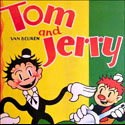
I don’t ever remember seeing any cartoons with The Cat in them,but I remember watching a few Goodie the Gremlin ones. What’s the name of the cartoon in which Goodie babysits his cousin (I think he was Goodie’s cousin) & tells him his versions of Ponce De Leon & the Fountain of Youth and Pocahontas?
That would be “Tell Me A Badtime Story”, released in the fall of ’63.
http://www.dailymotion.com/video/xn0niy_tell-me-a-badtime-story_fun
I think there were four cartoons featuring Goodie Gremlin total.
Thanks Chris.
Eight “Cartoon Champions” reissues for the 1960-61 season. For some reason, Paramount apparently chose to give the Popeye reissues a rest, though they would be back next year.
1) “Rail Rodents”
2) “Robin Rodenthood”
3) “A Bicep Built for Two”
4) “Mouse Trapeze”
5) “Fido Beta Kappa”
6) “No Ifs, Ands or Butts”
7) “Candy Cabaret”
8) “The Oily Bird”
And in other news, today, instead of Columbus Day, it’s Farmer Al Falfa’s 100th birthday. Hooray! Please join me on YouTube for a hand-crafted two-minute mishmash of good old barnyard cartoon mayhem. https://www.youtube.com/watch?v=qseJ6pKV3sM
Here’s that drink recipe I promised. Ingredients: 2oz Old Crow, make that 4oz, 1 Tbsp molasses, 6oz ginger beer, enough lime juice to make your eyes all goobley, ice, 1 empty tin can, 1 gun. Shake potables together, pour into can, shoot hole in bottom, drink as it streams out. Repeat.
Happy Anniversary to You, Farmer Al! (Or call him Farmer Gray if you want, he don’t care!)
Very neat Farmer Al Falfa collection. I didn’t know that there were any color cartoons of this ‘ole guy. I also thought, until I watched this compilation of well-balanced moments, that the farmers name was one word: Alfalfa. Nice job, and thanks for letting us all know that today is an important in cartoon history!
I’m celebrating by wearing overalls and allowing dozens of mice and cats to throw rocks at my head!
Geez, and I had something planned I still didn’t finish.
Where’s “Uranium Blues” in that montage? I thought his swan song was noteworthy as he was the only silent cartoon character to appear in a Cinema Scope cartoon.
Where’s “Uranium Blues” in that montage? I thought his swan song was noteworthy as he was the only silent cartoon character to appear in a Cinema Scope cartoon.
Certainly Gene Deitch saw no use to transition the farmer to the modern, off-beat aesthetics he had in store during his tenure.
Beware of presentism, Mr. Mork.
“Cool Cat Blues” was interesting when it made it to TV two years later on ABC’s new Saturday morning Casper show because unlike most theatricals that dealt with timely subject that were past their time by the time they hit the small screen, The Ed Sullivan Show was still going strong and had another eight years to run on CBS. Kids who could stay up at least until 8:30 p.m. on Sunday nights could get the joke about Ed’s frozen personality, instead of having to either ask their parents about it, or figure out what the joke was referring to as they got older.
I could see how that worked pretty effectively for still staying relevant during the 60’s, much in the way I’m sure “Abner the Baseball” also might’ve resonated with kids who may know of Mickey Mantle’s achievement.
For years I had “Bouncing Benny” confused in my memory with “Gerald McBoing Boing”. Now that I see the cartoon again, I notice the differences but also the similarities. Both use limited animation and a “boing boing” sound effect, but Gerald didn’t speak in his cartoons and they never showed him in his teen years. This cartoon “Bouncing Benny” never did much for me as a child…it was mildly entertaining but not a favorite. Now I find it much more appealing and enjoyable. Thanks for letting us re-visit this one.
Didn’t know there were such late additions to the “Little Lulu” series. Would like to know what the audience reaction was to these late entries. The character remained popular in comic books for several years to come.
Speaking of comic books, I’m hoping we’ll get more about the Harvey Comics characters in this time period. I know the Casper TV show came out some time in the early 60’s. I’d be interested to learn the audience and critical reactions.
Thanks for continuing an endlessly fascinating saga….these posts all together spell out an amazing story. I never knew all of this before.
Yeah both cartoons follow the same theme of a kid with a certain unusual thing that makes them stick out from the rest. In the case of Gerald, it was his ‘voice’, for Benny, this rubbery elasticity. Both characters end up feeling down (more so for Gerald who nearly runs away from his problems at a critical point in his story). Both characters found a way to live with their handicap, for Gerald, being a sound effects artist while Benny finds a need when the time was right (even if it benefited the team he was waterboy to).
Oh, Lord…Smilin’ Ed.
Loved Boppin Hood! Especially the scene where the King played his violin ala Jack Benny and how his daughter The Princess rebelled against her father’s silly proclamation on banning all types of music including Be-Bop Jazz by secretly becoming a Beatnik. I wonder if The Cat inspired Warner Bros to come out with Cool Cat a few years later?
For years I thought The Cat and Cool Cat were both talkative knockoffs of the Pink Panther, but The Cat is way earlier than Pink. He was an interesting idea; an update on Bugs Bunny who was consciously too hip for the room. A sober Dean Martin. You kept wishing the cartoons were better.
Meanwhile, note that Paramount was still producing (or buying?) new live action short subjects. Aside from featurettes packaged with Disney’s animated features (to bolster short running times), I don’t remember seeing them onscreen or it ads. The solitary exception was a small theater in Squaw Valley that offered an outdated travelogue with smirking references to the Grand Tetons.
20th Century Fox was also releasing color Cinemascope live action 1-reel shorts under the “Movietone Adventures in Cinemascope” banner. Our museum has retired (and faded pink) 35mm prints of these dating as late as 1964. We also have a mid-1960’s Hearst Metrotone Newsreel, they were still producing those.
I notice that Paramount had shut down its newsreel at the time of this ad. Fox closed down its Movietone newsreel in 1963, and Universal’s was the last to go in ’66 (allegedly, it stuck around longer because it got money from a U.S. government agency). What kept the Hearst Metrotone company alive into the ’80s was its Screen News Digest produced for schools.
What kept the Hearst Metrotone company alive into the ’80s was its Screen News Digest produced for schools
I suppose as long as schools were still using 16mm they saw a purpose there.
Actually, it was Hearst Metrotone, with its News Of The Day (theatrical) and Screen News Digest (16mm) that were being funded under the counter by the U.S. Information Agency, who were attempting to use the newsreels to influence public opinion on the Vietnam war. (Source: “The American Newsreel,” by Raymond Fielding.)
Universal was simply cranking out a cheap newsreel by buying UPI’s TV news clip service (used by non-network stations,) blowing up the 16mm footage to 35mm, and adding their own narration and stock music. News Of The Day ended in November 1967, Universal Newsreel a month later.
Castle Films’ non-theatrical “News Parade” (and I assume also Hearst’s Screen News Digest) continued by buying copies of news footage from the TV networks and from NASA (the space race was big news in the 60’s and 70’s) and adding their own sound.
In England, newsreels soldiered on by becoming “feature magazines,” dealing with topics from The Beatles and Rolling Stones to auto racing to a then-teenage Arnold Schwarzenegger flexing for the camera. British Pathe’ News continued into the early-mid 70’s, and Fox Movietone until almost 1980.
Thanks for filling the cracks in my memory, Jeff. I had read Fielding’s book on “The March of Time,” and met him when he was dean of the FSU film school.
Eddie Lawrence starts his voices for Paramount at this time. Soon the Mercer-Questel-Beck voices would vanish and be replaced with Bob McFadden, Dayton Allen, and Bradley Bolke.
Hmmm, so was Bob McFadden the voice that was also used on “ASTRO BOY” and “KIMBA THE WHITE LION” English dubs?
No Kevin. I believed I’d mentioned this before, but the one actor who straddled Paramount Cartoons and Fred Ladd’s anime dubs (Astro Boy, Kimba, et al) was Gilbert Mack.
Meanwhile, Paramount revamped its live action shorts for 1960 but never had much interest in reissuing them for TV like the cartoons. Only the worst prints are available these days for viewing. Here is the above advertised and pictured A SPORT IS BORN…
https://www.youtube.com/watch?v=0i9AAq_6jAY
https://www.youtube.com/watch?v=1gd7E-pJJrk
It is a shame many of these simply fell on the wayside as they did simply for not seeing any future use on television (though Paramount didn’t care to add their last five year’s worth of cartoons to Harvey after the studio closed but I’m sure we’ll get to that soon enough).
A SPORT IS BORN must have looked spectacular on the wide-screen with all of the airplane shots and skydiving that impressed theater goers much as a previous Paramount feature film WINGS did 33 years earlier.
Apparently Paramount kept releasing the live-action shorts through the end of 1968 (technically the ’68-69 season) and this was a year after the last cartoons. Among these were some comedy shorts of Homer Groening (father of SIMPSONS’ Matt). This pattern was repeated by Warner Brothers-Seven Arts with a few final travelogue shorts for ’69-70 following the last Cool Cat cartoon. Universal axed both its Woody Woodpeckers and live-action shorts (mostly sports reels) the same year (1972). Columbia stuck mostly with live-action films for several years after Hanna-Barbera’s Loopy DeLoop ended apart from the National Film Board of Canada imports.
Surprisingly they aren’t all lost. Some were reissued in 16mm for schools. It is important to remember that the late 1950s through the early ’80s was a golden age for the school ephemeral movie (with Coronet, Encyclopædia Britannica, Learning Corporation of America and other companies operating at their peak) and the federal government pumping a lot of money into educational “media” post-Sputnik. (It was the rise of cheap VHS and the Reagan Era’s cutbacks in educational spending that brought this era to a catastrophic end.) Thus, some of these non-animated films did enjoy a second life… at least temporarily. Now the struggle is finding both original 35mm prints shown in theaters and 16mm dupes as many schools and libraries chucked a lot of material without considering its historical value.
TCM has shown a couple of Warner’s ’60s shorts like KINGDOM OF THE SAGUENAY and SEE HOLLAND BEFORE IT GETS TOO BIG. Warner also produced four of the popular-in-schools Bell Science specials with Frank Baxter.
Surprisingly they aren’t all lost. Some were reissued in 16mm for schools. It is important to remember that the late 1950s through the early ’80s was a golden age for the school ephemeral movie (with Coronet, Encyclopædia Britannica, Learning Corporation of America and other companies operating at their peak) and the federal government pumping a lot of money into educational “media” post-Sputnik. (It was the rise of cheap VHS and the Reagan Era’s cutbacks in educational spending that brought this era to a catastrophic end.) Thus, some of these non-animated films did enjoy a second life… at least temporarily. Now the struggle is finding both original 35mm prints shown in theaters and 16mm dupes as many schools and libraries chucked a lot of material without considering its historical value.
There’s still a few hanging by a thread these days, of course gone are the days of 16mm prints and VHS tapes in favor of DVD’s. Some of Coronet’s library is still owned/distributed through Phoenix Learning Group (using the Coronet crown in their logo).
http://www.phoenixlearninggroup.com
Another company of note is Pyramic Media, who has some Oscar-winning/nominated films in their collection.
http://www.pyramidmedia.com
Under the deal made with Marjorie Henderson Buell (“Marge”) to revive Little Lulu, she owned the copyright on at least one if not both of the completed cartoons; her name appearing in place of Paramount’s, though she or her successors eventually sold them back to the studio.
Apparently either Marge or Western Publishing saw no interest in an updated animated series of cartoons for their character.
Aside from the copyrights (which “Frog’s Legs” would sport a Paramount copyright instead), Marjorie and her agent William C. Erskine were given co-producer credits in place of the writer’s for both cartoons. It was a shame John Stanley wasn’t given his due at all, but I suppose the way the business worked back then.
https://www.youtube.com/watch?v=II0Wz3u3LIw
I see there’s a webpage that talks a bit about the making of “Alvin’s Solo Flight” and it’s potential as a pilot to a TV series that never happened.
http://cartoonician.com/marge-and-lulu-the-art-of-the-deal/
It’s interesting to see the post-1960 Paramount shorts, such as “Bouncing Benny”, with Harvey Films designations. When I saw them as a kid in the 1970s & early 1980s on TV, they had their original Paramount opening/closing titles.
The Harveytoons Show that Jerry worked on in the late 90’s added the “Harvey Films” copyright to all the post-1959 shorts that originally didn’t have them when they were originally aired in The New Casper Cartoon Show. I suppose they didn’t really need to but I guess they wanted consistency (although a few like 1958’s Finnegan’s Flea stil had their Paramount copyrights). From what I remember, they got Paramount’s permission to use their original elements to create these new transfers of the cartoons for that show.
I see Myron Waldman credited as head animator on one Modern Madcap and one Noveltoon. Was he just moonlighting?
Thinking about Bouncing Benny some more, the approach reminded of what was also being done by Disney during the time with the unique stop-motion works of Xavier Atencio and Bill Justice on such projects as “Noah’s Ark”, “A Symposium of Popular Songs” as as a few opening title sequences. Though while Atencio and Justice had used their technique as an artistic alternative to the usual hand-drawn process, Graham Place and Otto Feuer seemed more concerned to keep the animation quality high while finding a different approach to animate without needing to use cels. It was nice Kneitel let them do it this time even if the experiment went nowhere for the studio. Could you imaging a couple years down the road and Honey Halfwitch was animated this way, I could!
I see both Feuer and Place went on to work at Hal Seeger’s on a few things in the 60’s while Feuer spent his last years in the business at Filmation, not too bad I suppose, but certainly not a high point.
Thanks for putting up the info on ‘The Cat’. Are there listed toons on youtube or elsewhere where I could see these toons? I fondly remember them…and I thank you for listing them! Nice to know that there are fellow toonsers out there that remember the ‘Modern Madcaps’, Harveytoons, etc.